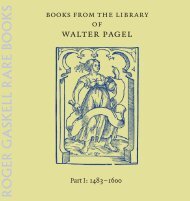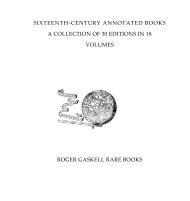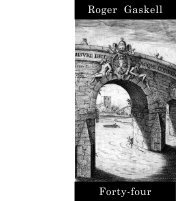pdf - Roger Gaskell Rare Books
pdf - Roger Gaskell Rare Books
pdf - Roger Gaskell Rare Books
Create successful ePaper yourself
Turn your PDF publications into a flip-book with our unique Google optimized e-Paper software.
philosophy, is topical in another respect too. In 1600 Giordano Bruno had<br />
been burnt at the stake in Rome, and it has been suggested, by Jean Jacquot,<br />
that Hill’s book was a tribute to his memory. But if so, Hill was careful to<br />
cover himself: he cites Bruno (as ‘Nolanus’) explicitly in a marginal note<br />
only; he states, in the title and in the dedicatory epistle, that he is oVering<br />
hypotheses only (‘proposita simpliciter, non edocta’); and he declares that if<br />
any of them is contrary to the Catholic faith, ‘igni illud et inferis mando’ (‘I<br />
commit it to the Xames and hell’). And if he published the book in Catholic<br />
Paris, the centre of Lullian studies, he sought safety for himself in protestant<br />
Rotterdam.’ (Hugh TrevorRoper in ODNB.)<br />
Rousset, Exercitatio medica assertionis novae (1603). A treatise on the<br />
dis puted septum of the heart. Rousset is famous for his Traitté nouveau de<br />
l’hysterotomotokie (Paris, 1581), the Wrst monograph on the Cesarian section<br />
(for Pagel’s copy of the 1590 edition, see my Catalogue 41, no. 109). This<br />
and his other works were based on practical experience. The present work<br />
however ‘ne correspond point aux autres. Son auteur, tout occupé de théorie,<br />
ne lui a pas même donné un air de vraisemblance’ (Bayle and Thillaye, I, p.<br />
372). Rousset’s dates are unknown, but because of the rarity of this book, his<br />
death is usually put earlier, Krivatsy suggesting 1590.<br />
Provenance. Fenton was a prominent member of the BarberSurgeons’<br />
Company and twice Master. He was one of the resident surgeons at Barts<br />
Hospital where his colleagues included John Woodall (author of The surgions<br />
mate, see below) and William Harvey. He had a licence from the College of<br />
Physicians to administer internal medicines. He published no books of his own,<br />
but he evidently had a substantial library which was left to his grandson, Joseph<br />
Colston, also a medical man. Colston died in 1675 and it was presumably<br />
some time after this that the library was dispersed. Sir Hans Sloane acquired<br />
most of his holdings of Fenton’s books in 1686, a few later. The Sloane Printed<br />
<strong>Books</strong> databases currently lists 305 items from Fenton’s library, the majority<br />
on surgery and medicine and almost all in Latin. Fenton’s active engagement<br />
with the books in his library is shown by two extensive commonplace books in<br />
the British Library in which he compiled texts from a range of printed books<br />
and added his comments (Sloane 1719 and Sloane 661).<br />
David Pearson, ‘Illustrations from the Wellcome Library: Joseph Fenton and his<br />
<strong>Books</strong>’, Medical History 47 (2003) 239–248; Alison Walker, ‘Sir Hans Sloane’s<br />
Printed <strong>Books</strong> in the British Library’ in Giles Mandelbrote and Barry Taylor, eds,<br />
Libraries within the Library. The Origins of the British Library’s Printed Collections<br />
(2009) pp. 89–97 on pp. 95–97; Sloane Printed <strong>Books</strong> database www.bl.uk/<br />
catalogues/sloane.<br />
102<br />
JENNER, Edward (1749–1823)<br />
A letter to Charles Henry Parry ... on the influence of artificial<br />
eruptions, in certain diseases incidental to the human body, with an<br />
inquiry respecting the probable advantages to be derived from further<br />
experiments.<br />
London: printed for Baldwin, Cradock, and Joy, 1822.







